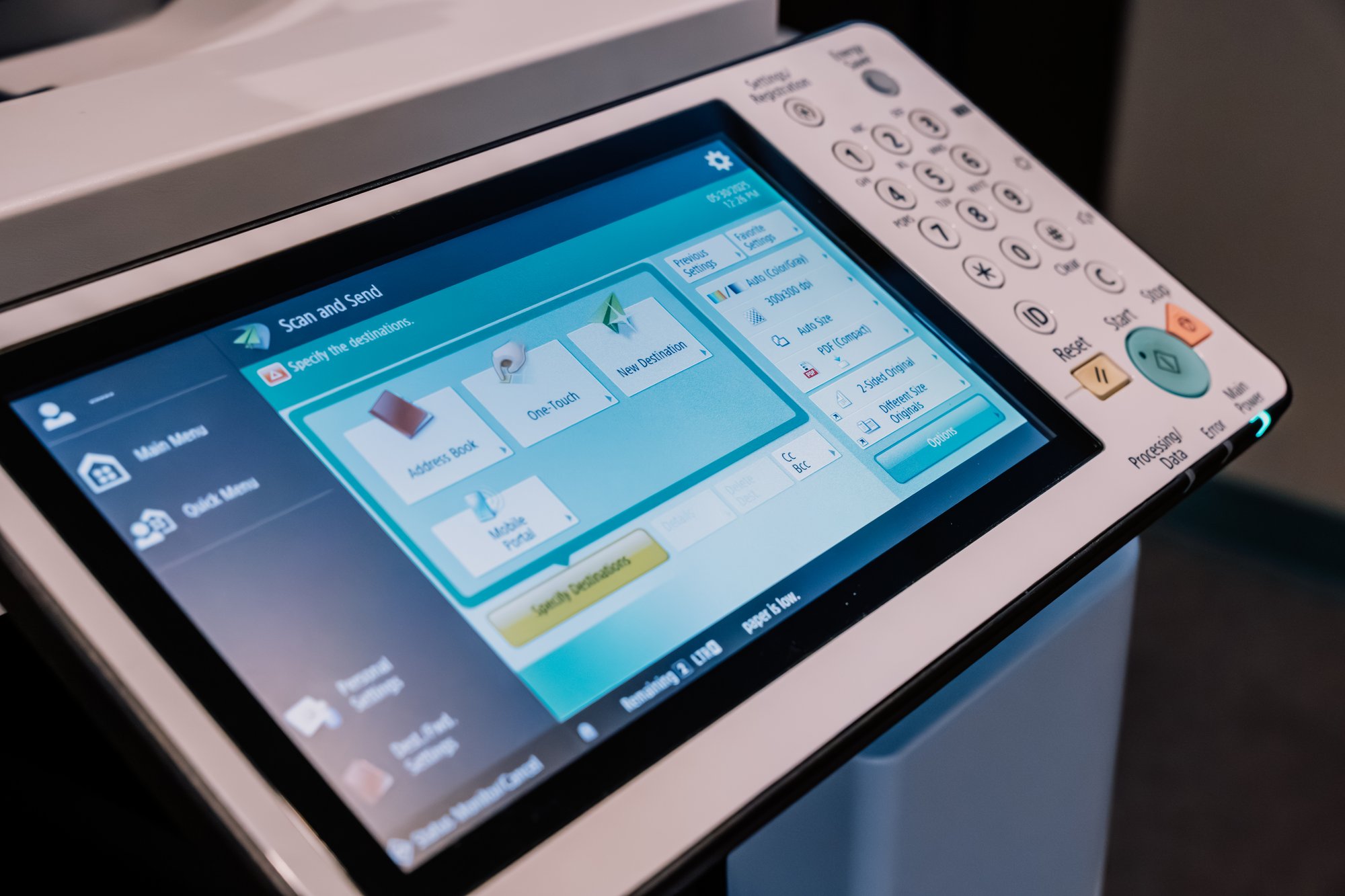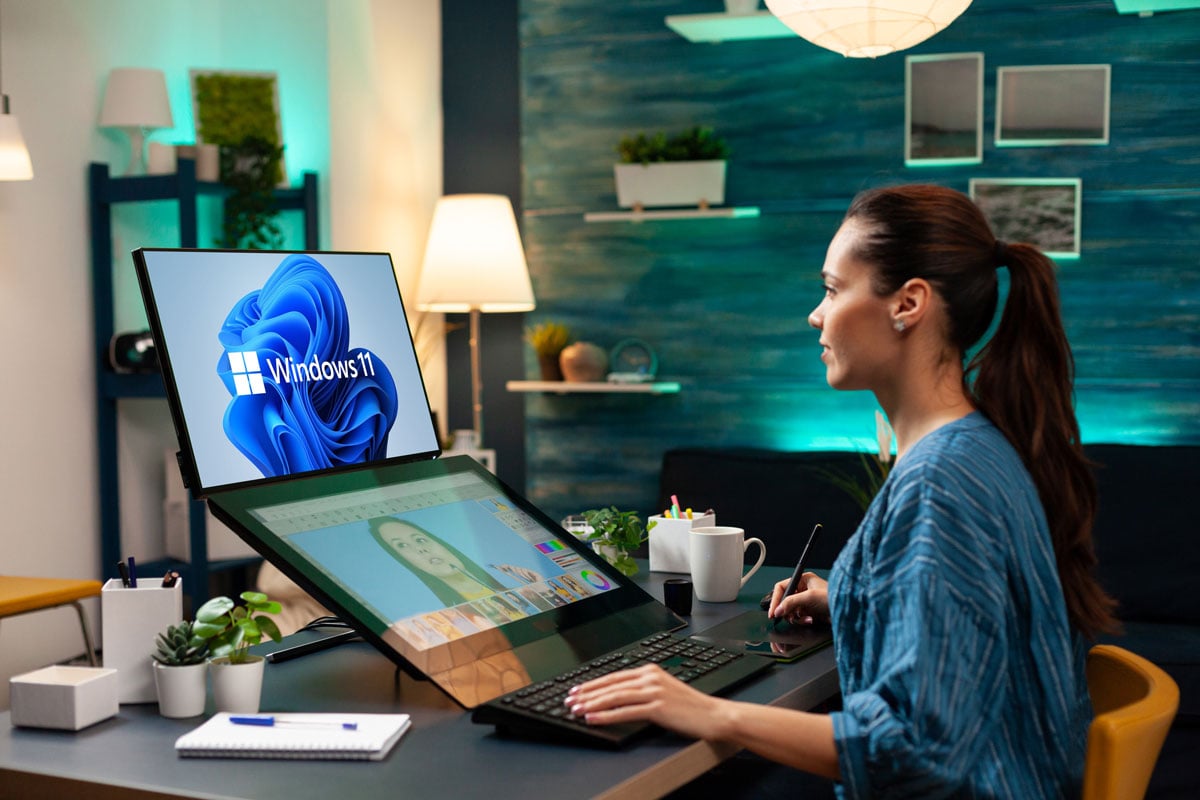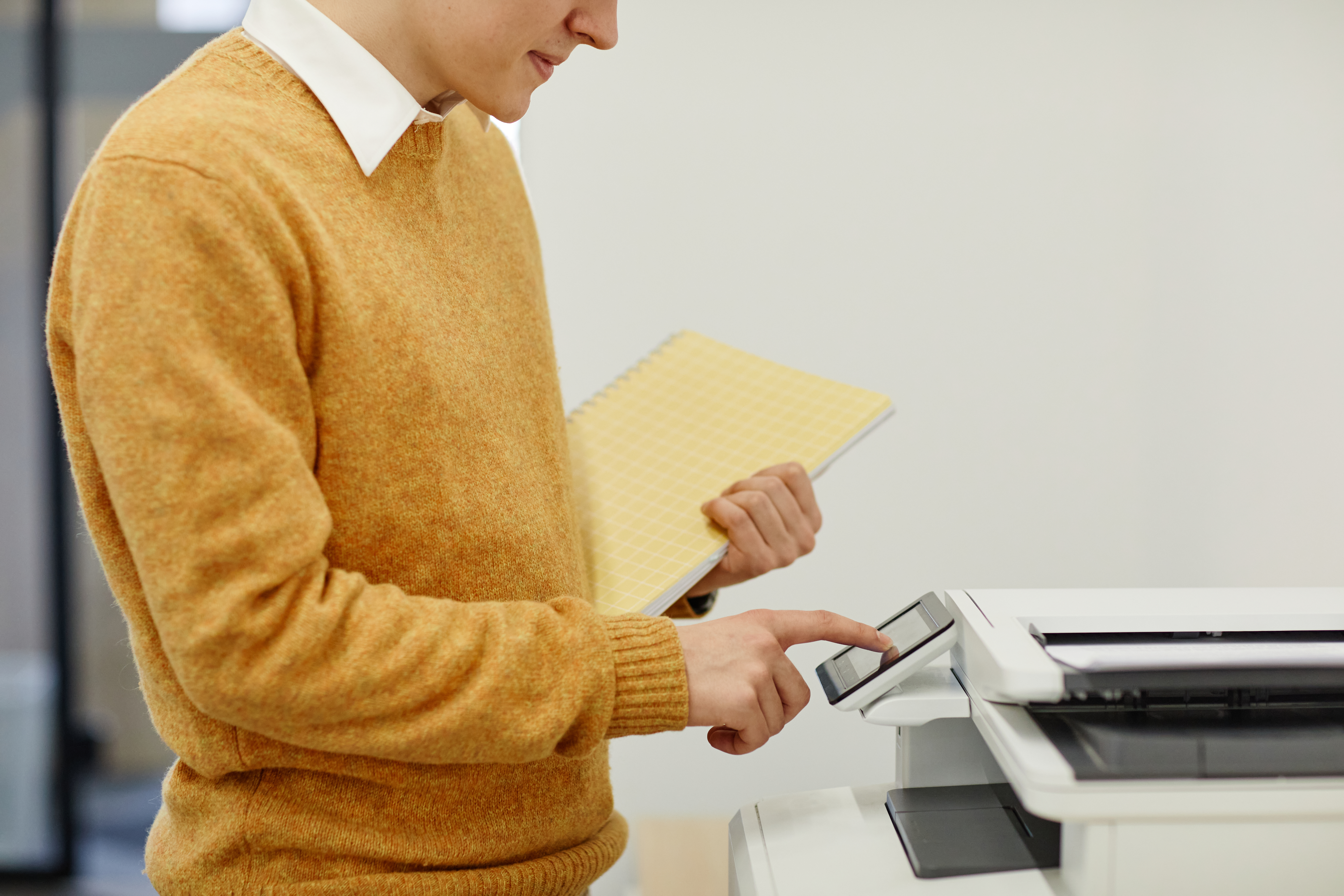How to Set Up Scanning to Email on Your Canon Copier
Setting up “scan-to-email” on your Canon copier allows you to scan documents and send them directly to an email address – a huge time-saver for any office. At American Business Machines, we don’t just sell you the devices you need for your business; we offer award-winning service to get you up and running with your new Canon machine quickly. In this guide, we’ll walk you through the process step-by-step. We’ll focus on modern Canon imageRUNNER ADVANCE DX series copiers (and similar models), highlighting where interfaces might differ between models. Follow along for clear instructions, optional screenshots, and a troubleshooting section to address common issues. Let’s get started!

Before You Begin: What You’ll Need
- Network Connection: Ensure your Canon copier is connected to your office network. Scanning to email won’t work if the device isn’t on the network (wired or Wi-Fi) and able to reach the mail server.
- SMTP Email Server Details: You’ll need the settings for an outgoing email server (SMTP). This could be your company’s email server (e.g. Microsoft 365/Exchange or Google Workspace) or a public service (like Gmail). Gather the following info:
- SMTP Server Address (e.g. smtp.office365.com or smtp.gmail.com)
- SMTP Port Number (e.g. 587 is common for TLS encryption)
- Encryption/SSL Requirement (most servers require TLS/STARTTLS for security)
- Authentication Info: whether the server requires login, and if so, a valid email username and password. Typically this is the email address and password for the account that will send the scans.
- SMTP Server Address (e.g. smtp.office365.com or smtp.gmail.com)
- Email Account Credentials: It’s best to use a dedicated email account for the copier (e.g. scanner@yourcompany.com), but you can use any account you have permission to use. Tip: For services like Gmail, Yahoo, iCloud, etc., you may need to enable an app-specific password due to security policies. (Gmail, for example, requires enabling 2-step verification and using a generated App Password for the device to log in.)
- Copier Admin Access: Access to the copier’s settings. On Canon imageRUNNER devices, this can be done via the Remote UI (the web interface) or directly on the machine’s control panel. The Remote UI method is often easier for entering text. You’ll need the device’s IP address and an admin login (System Manager ID/Password or equivalent). If you don’t have this info, check with your IT admin or the person who set up the copier.
With these prerequisites in place, you’re ready to configure scan-to-email on the copier.
Step-by-Step Instructions: Configuring Scan to Email
Follow these steps to set up the scan-to-email function on your Canon copier. The instructions below use the Remote UI (web interface), which is generally user-friendly. (You can also configure these settings on the copier’s touch panel via Settings > Registration, but the menus and keyboard entry might be a bit more cumbersome on the device.)
- Find the Copier’s IP Address: On many Canon models, you can find the device’s IP address by pressing the Counter Check or “123” button on the control panel. The IP address will be listed on the display (often in a corner of the screen). Jot down this IP address – you’ll need it to access the Remote UI. If you can’t find the IP on the screen, you might print a network settings report or ask IT for the device’s IP.
- Access the Remote UI in a Web Browser: Open a web browser on a computer that’s connected to the same network as the copier. In the address bar, type the copier’s IP address (e.g. http://<IP-address>) and hit Enter. You should see the Canon Remote UI login page load. (It may look like a Canon login screen asking for a user name and password.)
- Log In as Administrator: When the copier’s webpage loads, you’ll need to log in with administrative credentials to change settings. Enter the System Manager ID and PIN or the Administrator username/password. If you’re not sure, try common defaults: the username Administrator with a blank password (or password like “7654321” or “1234567”). Some devices use a Department ID and PIN login – the default Dept. ID is often “7654321” with PIN “1234567” (or vice versa) if it hasn’t been changed. If those don’t work and you don’t know the password, you may need to get the credentials from your IT or the person who set up the copier. Once you log in, you’ll have access to the Remote UI settings.
- Open the E-mail Settings Menu: Once logged in, click on Settings/Registration in the Remote UI home screen (this is the general settings area). Navigate to the Send function settings: under Function Settings, find Send in the sidebar menu, then click Network Settings – E-Mail/I-Fax Settings. (See image below for an example interface.) This will open the configuration page where you can input the scanner’s email (SMTP) settings. On many imageRUNNER ADVANCE models, this is the screen for scan-to-email setup.
- Enter the SMTP Server Details: You should now see a form or fields to configure the email sending settings. Fill in the fields as follows:
- SMTP Server Address: Enter the address of your SMTP server (for example, smtp.gmail.com for Gmail, smtp.office365.com for Microsoft 365, etc.). If you have an internal mail server or relay, use its hostname or IP address.
- SMTP Port Number (SMTP TX): Enter the port number your email server uses for outgoing mail. Common values are 587 (for TLS encryption) or 465 (for SSL), or 25 if using unencrypted or internal relay (though TLS is highly recommended). Use the port your provider or IT admin gave you.
- E-Mail Address: Enter the sender email address that the copier will use when it sends scans. This is the “From” address that recipients will see. It should be a valid email that you have permission to use (e.g. your company scanner’s email account).
- Use TLS/SSL (Encryption): If your SMTP server requires a secure connection (most do), enable the option for TLS/SSL. In Canon settings this might be a checkbox like “Allow TLS (SMTP TX)” – make sure it’s checked for services like Gmail/Outlook which require encryption. If your mail server doesn’t support encryption or uses a different security method, set this accordingly (but again, most modern services will be TLS).
- SMTP Authentication: In the settings page, find the option for authentication (often a checkbox labeled “Use SMTP Authentication (SMTP AUTH)”). Check this box if your SMTP server requires a login to send email (again, most do). Once checked, fields for a username and password will be available. Enter the username (typically the same as the email address you entered above) and the password for that email account. \n Important: If you are using a service like Gmail, Yahoo, or another provider with two-factor authentication, you’ll need to use an App Password instead of your regular email password. For example, with a Gmail/Google account, generate a 16-digit app password specifically for the copier (after enabling 2-Step Verification) and use that here, since Google blocks devices from using your normal password. (Canon copiers don’t support Google’s OAuth login, so the app password is the workaround.) If using Office 365 and multi-factor auth, you may also need an app password unless your admin has set up an exception or SMTP relay.
- Reply-To/Email TX Settings (optional): Some models allow setting a “Reply-To” address or email header info. This is optional – you can usually leave it as default (which is the sender email).
- SMTP Server Address: Enter the address of your SMTP server (for example, smtp.gmail.com for Gmail, smtp.office365.com for Microsoft 365, etc.). If you have an internal mail server or relay, use its hostname or IP address.
- Double-check all entries for accuracy – a single typo in the server name or password will cause scan-to-email to fail.
- Save and Test the Configuration: After entering the details, click OK or Save in the Remote UI to store the settings. Many Canon copiers provide a button to Test the SMTP settings (often labeled “Check SMTP Connection” or similar) – if available, click this to have the machine attempt a connection to the mail server. The device will report if the connection is successful. If the test passes, you’ve successfully configured the email settings! If it fails, re-check the details (we’ll cover troubleshooting in a moment). Note that some Canon models might require a restart after changing network settings. If your machine prompts you or if the settings don’t seem to take effect, try turning the copier off and back on (or use the Remote UI’s reboot function) to ensure the new email settings are applied.
- (Optional) Register Email Addresses in the Address Book: This step isn’t required for sending scans, but it can make sending to frequent recipients quicker. You can add commonly used email addresses to the copier’s address book or one-touch buttons. This can usually be done via the Remote UI under Address Book settings, or on the device’s panel (look for an Address Book/Contacts option in the menu). For example, you might create an address book entry for “Accounts Payable” with the email address of your accounting department. Later, users can just select “Accounts Payable” on the touch screen instead of typing the full email each time. If you prefer not to do this now, you can always manually enter an email address at scan time (see next section), but having address book entries for frequent contacts is a nice convenience.
Once these steps are complete, your Canon copier should be all set to send scanned documents via email. Now, let’s go over how to actually use the scan-to-email function in daily practice.
Using the Scan-to-Email Function (Sending a Scan)
After configuration, sending a scanned document to email is straightforward. While the exact touch-screen layout can vary by model, the general process is the same across Canon’s multifunction copiers:
- Initiate the Scan Mode: On the copier’s home screen, press the “Scan and Send” button. (On some models, this may simply be labeled “Send” or found under a general Scan function menu. On smaller devices or earlier models, you might press a Scan button then choose “Attach to Email” or similar.) This will open the scanning interface on the touch panel.
- Place Your Document: Load the documents you want to scan. You can use the automatic document feeder (ADF) for multi-page documents (face-up, top of page in first), or place a single sheet on the scanner glass (face-down).
- Select the Destination Email: Choose who you’re sending the scan to. You have a few options on the screen: you can select a contact from the Address Book or a programmed One-Touch button if you set those up earlier, or you can enter a New Destination on the fly.
- To use the address book: Tap the Address Book icon and find the desired recipient from the list, or tap a One-Touch key if you’ve created one for that email. The name/email should then appear as the destination.
- To send to a new email: Tap the New Destination option, choose E-mail as the destination type, and you’ll be prompted to enter the email address manually on the touch screen. (Use the on-screen keyboard to type the address, then OK/Confirm to add it as the recipient.)
- You can typically add multiple recipients too (Cc/Bcc), but for simplicity, try with one email first.
- To use the address book: Tap the Address Book icon and find the desired recipient from the list, or tap a One-Touch key if you’ve created one for that email. The name/email should then appear as the destination.
- Check Scan Settings (Optional): Before sending, you can adjust any scan settings if needed. By default, the machine will scan in PDF format at a standard quality. If you need to, you can change settings like color vs. black & white, resolution (dpi), file format (PDF/JPEG/TIFF), scan duplex (1-sided or 2-sided), etc. These options are usually available under an Options or Settings button on the scan screen. For most day-to-day scans, the defaults will be fine, but it’s good to know you can tweak these (for example, if you want to scan in color or make the file smaller).
- Send the Scan: Press the Start button (often a physical green button or an on-screen “Start Scan” prompt). The copier will begin scanning your document. Once all pages are scanned, it will connect to the SMTP server and send the email out. You might see a message like “Sending...” on the screen. After a moment, the device typically reports the job status – if everything is set up correctly, it should say the send was successful. The recipient should receive an email from the copier’s address with the scanned document attached (usually as a PDF). 🎉 Success!
- Confirm Delivery (Optional): If you want to ensure the email went through, you can check the recipient’s inbox or ask them to confirm receipt. Additionally, many Canon copiers have a Status Monitor or Send Log you can check on the device for a “TX (transmit) OK” status. If there was a problem, you might see an error message or error code on the copier’s display (which we’ll address below).
That’s it – you’ve sent a scan to email directly from your copier. Once set up, users can repeat these steps anytime to quickly email documents to themselves or others, without needing a computer in the middle.
Differences Between Models and Common Options
Canon’s interface is fairly consistent across the imageRUNNER ADVANCE series, but there are some differences to be aware of:
- Interface Labels: Newer imageRUNNER ADVANCE DX models use a touchscreen with a home screen button labeled “Scan and Send.” Older imageRUNNER models (or those with slightly different firmware) might label the function just “Send” or have it under a Scan menu. For example, some smaller office models might require pressing a Scan button then choosing “Send to Email” from a list of scan options. Despite the label differences, the core functionality is the same.
- Remote UI vs. On-Device Setup: We demonstrated using the web interface (Remote UI) because it’s easier to type and navigate. Alternatively, you can configure scan-to-email directly on the machine’s control panel. On a touchscreen model, you’d go to Settings/Registration > Function Settings > Send > Network Settings > E-Mail/I-Fax and enter the SMTP info using the on-screen keyboard (very similar to what we did in the browser). On models without a touchscreen (or smaller LCD menus), you’d use the arrow keys to navigate menus for Network Settings and enter SMTP info. The settings have the same names (SMTP Server, port, etc.), but it can take a bit longer to input with few buttons. If you’re comfortable with it, the Remote UI method saves time.
- Feature Availability: Nearly all Canon multifunction copiers support scan-to-email, but very old models or entry-level printers might not have it or might require a special setup. The instructions here assume a Canon device that has a Scan-to-Email (Scan and Send) capability. If you cannot find any option for email, check your model’s specifications – it might be a print-only device or require an add-on. (All imageRUNNER ADVANCE series have it built-in, and most imageCLASS devices do as well, though the setup menus will differ.)
- Address Book and One-Touch Buttons: How you register and access stored email addresses can differ. Advanced models let you create multiple address books, import contacts, and set up one-touch keys on the home screen for frequent destinations. Smaller models might just have a single list of contacts. In any case, the idea is to save addresses to avoid retyping – use whatever method your model provides to manage contacts easily. Consult your model’s user manual for the exact steps to add/edit address book entries if needed.
- Sending Options: Some high-end models have extra Send options like Send to File Server, Send to Fax, Send to Myself, etc., in the same “Scan and Send” area. For instance, “Send to Myself” might automatically use the logged-in user’s email. These can be handy, but for a general office worker just needing basic scan-to-email, you can ignore the extra bells and whistles. Just ensure you’re in the mode to send to E-mail (which is the default for “Scan and Send”).
In summary, while the button placements or menu names might vary slightly, the process – configuring SMTP settings and then using Scan -> Email – is fundamentally the same across Canon copiers. When in doubt, refer to the user manual for your specific model (look up the section on “Send Settings” or “E-mail Settings”), or reach out to a service technician for guidance. Once you’ve done it on one Canon, you can handle others with confidence, as the workflow is very similar.
Troubleshooting Common Scan-to-Email Issues
Even with the correct setup, you might encounter some hiccups when sending scans via email. Here are some common issues and how to address them:
- Email Not Sending (Network/Server Errors): If the copier shows an error or the emails never arrive, first check the basics. Is the network up? Can the copier “see” the mail server? A common error code is #752, which indicates the device cannot reach the SMTP server at all. This could be due to a wrong SMTP address (e.g., a typo in the server name) or a network issue (e.g., the copier has no internet access or DNS is misconfigured). Ensure the SMTP Server address is correct and that the copier has a proper network connection (IP address, DNS server, gateway). If you’re using a hostname (like smtp.gmail.com), make sure the copier’s DNS settings are correct so it can resolve that name. If using an IP address for SMTP, ensure it’s reachable. In some cases, a firewall might be blocking the SMTP port – you may need your IT department to allow the copier to communicate on port 587/465/etc.
- Authentication Problems (Username/Password Errors): If you see an error related to authentication (for example, Canon error #806), it typically means the login to the SMTP server failed – in other words, the username or password is likely incorrect. Double-check the email account credentials you entered. Keep in mind, if the email account’s password was recently changed, you’ll need to update the copier’s settings too. Services like Gmail/Yahoo might reject the login if you haven’t used the required app password – resulting in an auth error even if the password was “correct” for your normal login. Generating and using an App Password (as discussed earlier) usually resolves this. Also verify that “SMTP Authentication” was enabled in the settings if your server requires it – if that box is unchecked, the copier won’t even attempt to log in and the send will fail.
- SMTP Encryption (TLS/SSL) Issues: If the machine reports a timeout or handshake failure (often shown as error #801, a timeout communicating with the server) it may be due to an encryption mismatch. For example, if your SMTP server requires TLS and you left it disabled (or vice versa), the connection can’t be established. Make sure Allow TLS (or the equivalent setting) is turned on if using a modern service. Conversely, if you’re using a private SMTP relay on your network that doesn’t use encryption, you might try turning TLS off. Another TLS-related tip: check the copier’s date and time – if the device’s clock is far off, TLS certificate validation could fail. Ensuring the date/time is correct (or enabling NTP sync) can sometimes fix weird TLS errors.
- Provider-Specific Security Blocks: Some email providers have security measures that can block “less secure” apps (like printers/scanners) from sending email. A notable example is Google – if the scan-to-email isn’t working with Gmail, Google might be blocking the sign-in attempt. Canon error #839 is one code that indicates the server is rejecting the connection for security reasons. The solution is usually to adjust the email account’s security settings: enable 2-Step Verification on the account and use an App Password for the copier (as mentioned above). Similarly, Yahoo and iCloud email require app passwords and proper SSL/TLS ports. Office 365 (Microsoft 365) might require that the account has “Authenticated SMTP” enabled and, if MFA is on, again an app password or special setup. If you suspect the provider is blocking the device, log into the email account on a PC – sometimes you’ll find a security alert (e.g. “we blocked a sign-in from a new device”). Following the provider’s prescribed steps for allowing the device will resolve this.
- Check the Copier’s Error Log: When a scan-to-email fails, the Canon will often display an error message with a code, or even print a communication management report if configured to do so. These error codes are extremely useful for pinpointing the issue. For instance, as noted, #752 means it couldn’t reach the server, #801 means it timed out (often server or port issue), #806 means authentication error, #839 means the SMTP server rejected the connection (often due to policy). If you get a code, you can look up Canon’s official list of error codes in the user manual or online to get more details on the cause. The copier’s Status Monitor/Job Log can also show error codes for send jobs. Use these clues to guide your troubleshooting – for example, an auth error tells you to focus on username/password, whereas a network error tells you to check connectivity or addresses.
- Email Size and Scan Settings: Keep in mind that very large scans might fail to send if they exceed your email provider’s size limits. If a scan job is failing and you’ve confirmed the settings are right, consider the scan size – dozens of high-resolution color pages could create a PDF that’s tens of MB in size, which some servers reject. In such cases, try scanning at a lower resolution or splitting the document. Canon copiers often have a setting to divide scans into multiple emails if the file is over a certain size. This typically isn’t an “error,” but something to be aware of if recipients report not getting emails for large scans.
- Still Having Trouble? If you’ve checked all of the above and scan-to-email still isn’t working, it might be time to involve your IT department or a service professional. There could be advanced issues at play (such as SMTP ports being blocked by your network firewall, the copier’s firmware being out-of-date for modern authentication methods, etc.). At ABM, we support many clients with these configurations – sometimes it’s as simple as a typo, other times we coordinate with the client’s email provider to allow the device to send. Don’t hesitate to reach out for help if needed; ensuring your copier is properly configured is part of maintaining an efficient office workflow.
Conclusion
Once configured, scanning to email on your Canon copier can greatly streamline how you distribute and digitize documents. No more scanning to a PC, saving, and manually emailing – the machine does it all in one go. We hope this guide helped you set up your Canon imageRUNNER ADVANCE DX (or similar model) for scan-to-email. Remember to keep your SMTP settings updated if your email account password changes or if you switch email providers. And always prioritize security (use app passwords and TLS where applicable) to keep your information safe in transit.
With your Canon copier reliably sending scans to email, your office can enjoy faster document workflows and improved productivity. Happy scanning, and if you have any questions or need further assistance, the team at American Business Machines is here to help!
Sources:
.png?width=500&height=500&name=Untitled%20design%20(16).png)


